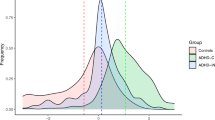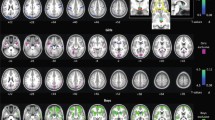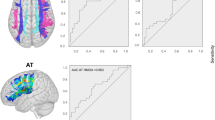Abstract
Attention-deficit/hyperactivity disorder is a highly heritable and prevalent neuropsychiatric disorder estimated to affect 6% of school-age children1,2,3. Its clinical hallmarks are inattention, hyperactivity and impulsivity4,5, which often respond substantially to treatment with methylphenidate or dextroamphetamine. Etiological theories suggest a deficit in corticostriatal circuits, particularly those components modulated by dopamine. We developed a new functional magnetic resonance imaging procedure (T2 relaxometry) to indirectly assess blood volume in the striatum (caudate and putamen) of boys 6–12 years of age in steady-state conditions. Boys with attention-deficit/hyperactivity disorder had higher T2 relaxation time measures in the putamen bilaterally than healthy control subjects. Relaxation times strongly correlated with the child's capacity to sit still and his accuracy in accomplishing a computerized attention task. Daily treatment with methylphenidate significantly changed the T2 relaxation times in the putamen of children with attention-deficit/hyperactivity disorder, although the magnitude and direction of the effect was strongly dependent on the child's unmedicated activity state. There was a similar but nonsignificant trend in the right caudate. T2 relaxation time measures in thalamus did not differ significantly between groups, and were not affected by methylphenidate. Attention-deficit/hyperactivity disorder symptoms may be closely tied to functional abnormalities in the putamen, which is mainly involved in the regulation of motor behavior.
This is a preview of subscription content, access via your institution
Access options
Subscribe to this journal
Receive 12 print issues and online access
$209.00 per year
only $17.42 per issue
Buy this article
- Purchase on Springer Link
- Instant access to full article PDF
Prices may be subject to local taxes which are calculated during checkout


Similar content being viewed by others
References
Anderson, J.C., Williams, S. & McGee, R. DSM-III disorders in preadolescent children: prevalence in a large sample from the general population. Arch. Gen. Psychiatry 44, 69–76 (1987).
Bird, H.R., Canino, G. & Rubio-Stipec, M. Estimates of the prevalence of childhood maladjustment in a community survey in Puerto Rico. Arch. Gen. Psychiatry 45, 1120–1126 (1988).
Szatmari, P., Offord, D.R. & Boyle, M.H. Ontario child health study: prevalence of attention deficit disorder with hyperactivity. J. Child Psychol. Psychiatry 30, 219–230 (1989).
Barkley, R.A. A critique of current diagnostic criteria for attention deficit hyperactivity disorder: clinical and research implications. J. Dev. Behav. Pediatr. 11, 343–352 (1990).
Tryon, W.W. The role of motor excess and instrumented activity measurement in attention deficit hyperactivity disorder. Behav. Modif. 17, 371–406 (1993).
Orvaschel, H. & Puig-Antich, J. The Schedule for Affective Disorders and Schizophrenia for School-Age Children-Epidemiologic Version (Kiddie-SADS-E) (University of Pittsburgh, Pennsylvania, 1987).
Ogawa, S., Menon, R.S., Kim, S.G. & Ugurbil, K. On the characteristics of functional magnetic resonance imaging of the brain. Annu. Rev. Biophys. Biomol. Struct. 27, 447–474 (1998).
Pauling, L. & Coryell, C. The magnetic properties and structure of hemoglobin, oxyhemoglobin, and carbonmonoxyhemoglobin. Proc. Natl. Acad. Sci. USA 22, 210–216 (1936).
Kety, S. Measurement of local blood flow by the exchange of an inert, diffusible substance. Methods Med. Res. 8, 228–236 (1960).
van Zijl, P.C. et al. Quantitative assessment of blood flow, blood volume and blood oxygenation effects in functional magnetic resonance imaging. Nature Med. 4, 159–167 (1998).
Goldberg, M.A., et al. Value of T1 and T2 relaxation times from echoplanar MR imaging in the characterization of focal hepatic lesions. Am. J. Roentgenol. 160, 1011–1017 (1993).
Teicher, M.H., Ito, Y., Glod, C.A. & Barber, N.I. Objective measurement of hyperactivity and attentional problems in ADHD. J. Am. Acad. Child Adolesc. Psychiatry 35, 334–342 (1996).
Lou, H.C., Henriksen, L. & Bruhn, P. Focal cerebral hypoperfusion in children with dyspasia and/or attention deficit disorder. Arch. Neurol. 41, 825–829 (1984).
Lou, H.C., Henriksen, L., Bruhn, P., Borner, H. & Nielsen, J. Striatal dysfunction in attention deficit and hyperkinetic disorder. Arch. Neurol. 46, 48–52 (1989).
Ernst, M., Liebenauer, L., Fitzgerald, G., Cohen, R. & Zametkin, A. Reduced brain metabolism in hyperactive girls. J. Am. Acad. Child Adolesc. Psychiatry 33, 858–868 (1994).
Ernst, M., Zametkin, A.J., Matochik, J.A., Jons, P.H. & Cohen, R.M. DOPA decarboxylase activity in attention deficit hyperactivity disorder adults. A [fluorine-18]fluorodopa positron emission tomographic study. J. Neurosci. 18, 5901–5907 (1998).
Graybiel, A.M., Aosaki, T., Flaherty, A.W. & Kimura, M. The basal ganglia and adaptive motor control. Science 265, 1826–1831 (1994).
Vaidya, C.J. et al. Selective effects of methylphenidate in attention deficit hyperactivity disorder: a functional magnetic resonance study. Proc. Nat. Acad. Sci. USA 95, 14494–14499 (1998).
Volkow, N.D. et al. Effects of methylphenidate on regional brain glucose metabolism in humans: relationship to dopamine D2 receptors. Am. J. Psychiatry 154, 50–55 (1997).
Greenberg, L. An objective measure of methylphenidate response: clinical use of the MCA. Psychopharmacol. Bull. 23, 279–282 (1987).
Paulus, M.P. & Geyer, M.A. The effectiveness of MDMA and other methylenedioxy-substituted pheylalklamines on the structure of rat locomotor activity. Neuropsychopharmacology 7, 15–31 (1992).
Maas, L.C., Frederick, B.D. & Renshaw, P.F. Decoupled automated rotational and translational registration for functional MRI time series data: the DART registration algorithm. Magn. Reson. Med. 37, 131–139 (1997).
Acknowledgements
We thank A. Smith and E. Connolly for collecting the fMRI data, and R. Feldman for help with technical writing. Support for this project was provided in part by National Institutes of Mental Health grant MH-48343 (M.H.T.) and National Institute on Drug Abuse grant DA-09448 (P.F.R.). C.M.A. was supported by special supplement to National Institutes of Mental Health grant MH-53636 (M.H.T.).
Author information
Authors and Affiliations
Rights and permissions
About this article
Cite this article
Teicher, M., Anderson, C., Polcari, A. et al. Functional deficits in basal ganglia of children with attention-deficit/hyperactivity disorder shown with functional magnetic resonance imaging relaxometry. Nat Med 6, 470–473 (2000). https://doi.org/10.1038/74737
Received:
Accepted:
Issue Date:
DOI: https://doi.org/10.1038/74737
This article is cited by
-
Childhood Physical Health and Attention Deficit/Hyperactivity Disorder: A Systematic Review and Meta-Analysis of Modifiable Factors
Prevention Science (2022)
-
Structural brain network topology underpinning ADHD and response to methylphenidate treatment
Translational Psychiatry (2021)
-
CK1δ over-expressing mice display ADHD-like behaviors, frontostriatal neuronal abnormalities and altered expressions of ADHD-candidate genes
Molecular Psychiatry (2020)
-
The interplay of delay aversion, timing skills, and impulsivity in children experiencing attention-deficit/hyperactivity disorder (ADHD) symptoms
ADHD Attention Deficit and Hyperactivity Disorders (2019)
-
Neonatal 6-OHDA lesion model in mouse induces Attention-Deficit/ Hyperactivity Disorder (ADHD)-like behaviour
Scientific Reports (2018)



